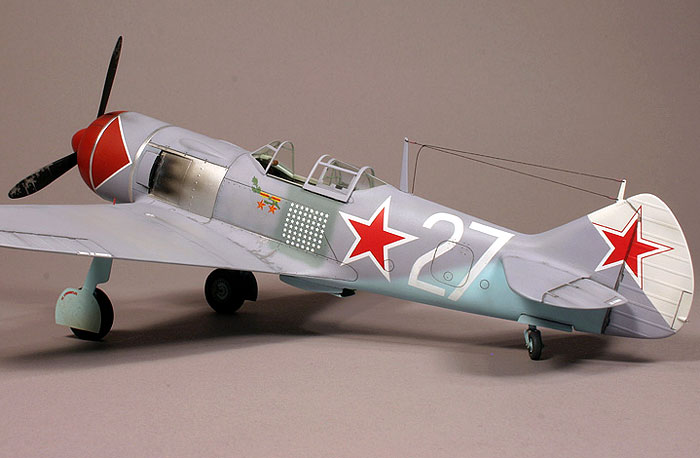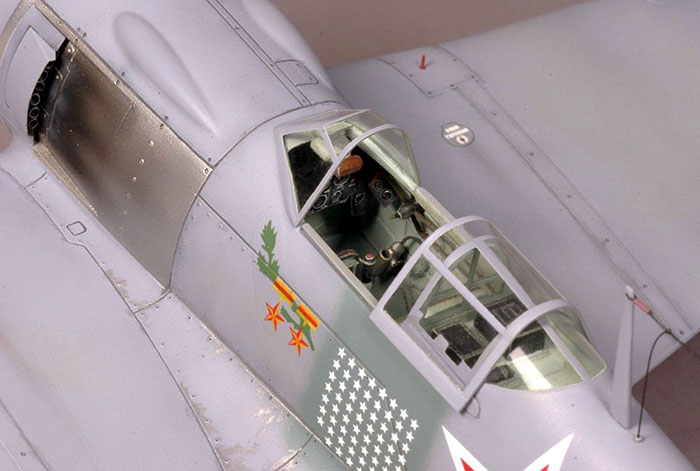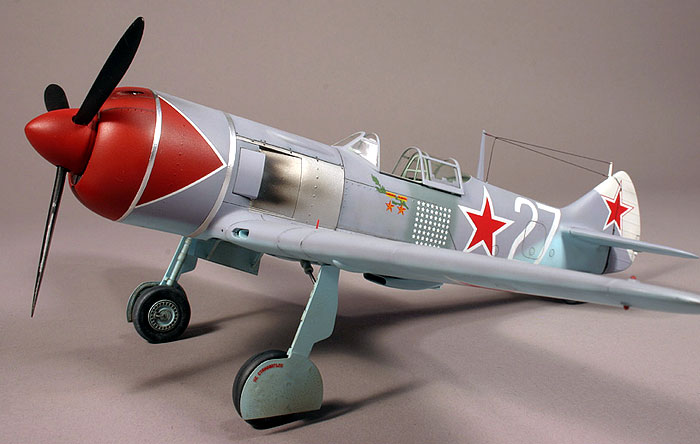|
Gavia’s 1/48 scale La-7
Red-Nosed Lavocka
by Aleksandar Šekularac
|
 |
|
Lavochkin La-7 |

Gavia's 1/48 scale La-7 is
available online from Squadron.com
Who is better?
It is hard to speak seriously of world’s greatest
fighter plane of a certain era.
There are many aspects that make a
design of an aircraft successful, and many designs that were never
compared face to face. Second World War is a period that receives much
attention, and flying machines that fought in it even more so. Therefore
it is often that one hears bold statements that one, or another is
certainly the ultimate fighter of the WWII. I won’t name the usual
suspects, as you all know them.
I will mention one aircraft that is
undeservingly forgotten though - the Lavockin La-7.

The La-7 came through a long wartime evolution of Lavockin design,
sourcing from LaGG-3. It dominated the skies over the eastern front, and Germany
during 1944 - 45 period.
The La-7 was a very purposeful design, being constructed
mostly of delta-wood (mix of wood and resin). Rugged, powerful yet
nimble, and with twin ShVAK cannons armed for the occasion. It eclipsed
in performance, and manoeuvrability its main opposition: FW-190’s and
Bf-109G/K’s. Late 3-cannon version was even more deadly, and much sought
after by Soviet pilots, but produced in smaller numbers.
The Pilot & His Plane
But certainly, more important than spec-sheets is
the man behind the throttle. In this particular case the name doesn’t
require much introduction. It is Ivan N. Kozhedub, triple hero of the
Soviet Union, and highest scoring allied ace of WWII. During the two
active years of combat flying he collected 62 recognized kills, while
his unofficial score is undoubtedly higher. He survived the war, and
continued to play important role in Aviation throughout his life,
ultimately receiving a title of “Marshal Aviatsii”.

Considering the fame of the pilot, it is almost beyond belief how little
is known about his last WWII plane: La-7, “white 27”. There is more
misinformation rattling around than actual facts. Only few period
photographs exist, and even these are highly fractional, leaving a great
deal for a debate. Recent research work by Erik Pilawskii is once again
unmatched in this area, and in his web article named: “Lost in Time...
The Misadventures of Ivan Kozhedub's Famous White 27", he gives
previously unknown perspective on wartime appearance, and subsequent
changes to this aircraft. Some details from 27’s post-war life are
almost more intriguing and mysterious than her combat service. For
anyone in interest, the text can be found by following this link:
http://vvs.hobbyvista.com/Markings/Kozhedubs_White27/index.php.
I used this article as a primary source of
information, and tried to model this famous plane as it looked in May of
1945, the time of Victory.
Building the
Gavia 1/48 scale La-7
|
The Kit
The clean lines of the La-7 have eluded plastic kit
industry for many years. In 1/48 scale there are today two main options
- the old Hobbycraft/Academy kit, and the much newer and little better
Gavia. When Gavia’s kit showed up on the market, it was immediately
hailed as the ultimate La-7. Well, all is relative. I will agree that it
is a better starting point than the Hobbycraft kit, but it is far from
perfect.
There are areas where Gavia is wildly inaccurate.
To name one, the fuselage spine behind the cockpit is too narrow (and
the fuselage is not deep enough for that matter). Consequently, the rear
part of the canopy is some 25% under-scaled in width! All this makes the
back part of Gavia’s La-7 look too “Spitfireish”. There is more, believe
me, but I don’t want to go into details.

I hear that the new Eduard La-7 in 1:72 scale is
more accurate. This means that they didn’t just scale down Gavia’s kit,
but rather designed a new one. Good news for small-scale modelers, and
kudos to Eduard. As for me, I am not holding my breath for ultimate
La5/7 family in 1:48 scale.
I wanted to make this model look more like La-7, so
I did a number of modifications to the kit, and here is a list:
-
 Widened
rear fuselage by inserting a plastic wedge along the spine. Widened
rear fuselage by inserting a plastic wedge along the spine.
-
Rebuilt cockpit
deck, and wall behind the pilot’s seat for widened fuselage.
-
Used excellent Part
PE set for cockpit, and other miscellaneous details.
-
Scratch-built
gun-sight, and some other cockpit detail.
-
Used Falcon vac
canopy parts (ironically, these are designed for Hobbycraft kit,
which is more accurate in width
-
Reshaped vertical
stabilizer.
-
Rebuilt the
spinner.
-
Hollowed out
compressor ducts in wing-roots.
-
Scratch-built
exhaust stacks.
-
Rebuilt inaccurate
second cowling ring.
-
Added rows of
rivets using compass needle.
-
Replaced tail, and
wing tip lights with clear bits.
-
Detailed landing
gear.
All markings were sourced out from somewhere else,
except for the kill marks and few stencils, which are from the kit.
All colors are from the new WEM range of Soviet
WWII paints (highly recommended).
So there you have it.
White 27, as flown by most famous Soviet ace.

Now I need to finish that AM Sturmovik, and one
representative of Yak family, say Yak-9T (now that will be a surgery,
but don’t get me started...), and I will have my basic Soviet Great
Patriotic War collection finished.
Detailed build-up article about my La-7 should appear in October 2004
release of British SAM magazine.
Click the
thumbnails below to view larger images:
LaGG & Lavochkin Aces of
World War 2
Aircraft of the Aces 56 |
|
|
|
|
Author: George Mellinger
Illustrator: Jim Laurier
US Price: $19.95
UK Price: £12.99
Publisher:
Osprey Publishing
Publish Date:
November 21, 2003
Details: 96 pages; ISBN: 1841766097 |
|
|
Model, Images and Text Copyright © 2004
by Aleksandar Šekularac
Page Created 15 May, 2004
Last Updated
14 May, 2004
Back to
HyperScale Main Page |
Home
| What's New |
Features |
Gallery |
Reviews |
Reference |
Forum |
Search